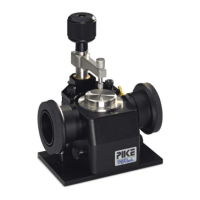PN 350-025004-09
Page | 11
Micrometer Pressure Clamp
The micrometer clamp assembly consists of the base which attaches directly to the accessory top plate
and the “r” shaped arm with control knobs for raising and lowering the sample press. The clamp itself is
a stainless steel barrel with the integrated micrometer screw at the top and the spring-loaded plunger at
the bottom. A spring is located between the shaft of the micrometer screw and the plunger. The spring
tension can be adjusted by changing the position of the micrometer screw. This adjustment allows
application of higher or lower pressure to the sample placed on the accessory’s sampling plate. The
numbers on the scale of the micrometer screw serve as reference (they do not indicate the actual
pressure applied to the sample). The actual pressure per square inch (psi) depends on the size of the tip
attached to the press and the spring tension. Listed below are the approximate pressures calculated for
the square edge stainless steel tip (diameter 0.125").
Lighter pressures should be used for soft, flexible samples. Higher pressures are necessary for hard
polymers, bids, granules, etc. (Please see also the note on selection of pressure clamp tips). The
following is a short procedure outlining proper use of the MIRacle micrometer controlled sample clamp
(025-3050):
1. Select the appropriate tip and attach it to the press.
2. Position the sample on the accessory plate.
3. Set the micrometer screw to 2.0.
4. Lower the press barrel with the control knobs, until the edge of the sampling tip touches the lower
brass end of the barrel.
5. Collect the sample spectrum.
Some FTIR spectrometers offer “spectrum preview” data collection modes. If available, you can
experimentally determine the best pressure for your particular sample by observing the intensity of the
spectrum while adjusting the micrometer screw.
NOTE: The spring in the clamp assembly is not compressed until the micrometer screw is set to 3.5. For
this reason, always keep the micrometer setting between 3.5 and 0.

